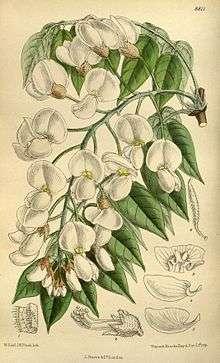Wisteria brachybotrys
Wisteria brachybotrys, the silky wisteria, is a species of flowering plant in the pea family Fabaceae from Japan. Some older references believed it to be of garden origin.[1] It is certainly very widely cultivated in its native Japan, with the white flowered cultivars more widely grown than the pale violet cultivars. It is in fact native to western parts of Honshu and throughout Shikoku and Kyushu, growing in mountain forests and woods from 100 to 900m.[2] It is not at all clear why it is less popular in the west than in Japan.
| Wisteria brachybotrys | |
|---|---|
 | |
| Scientific classification | |
| Kingdom: | |
| (unranked): | |
| (unranked): | |
| (unranked): | |
| Order: | |
| Family: | |
| Subfamily: | |
| Genus: | |
| Species: | W. brachybotris |
| Binomial name | |
| Wisteria brachybotris | |
The Greek specific epithet brachybotrys means “short clusters”.[3]
Growing to 19 m (62 ft) or more, it is a deciduous anticlockwise twining woody climber with hairy leaves to 35 cm (14 in) long, each leaf comprising up to 13 leaflets. The scented flowers, borne in late spring and early summer, are pale violet or white with a yellow blotch at the base. They hang in racemes up to 15 cm (5.9 in) long. They are followed by felted green seedpods containing pea-like seeds. These are reported to be toxic if ingested in quantity.[1]
Like its more famous cousins, Wisteria sinensis (Chinese wisteria) and Wisteria floribunda (Japanese wisteria), it requires support when grown as an ornamental. It may be trained up a tree, a wall or a pergola. It may also be trained as a half-standard tree. It is hardy down to −20 °C (−4 °F) but needs a sheltered position in sun or partial shade, and reliably moist soil.
The following cultivars have gained the Royal Horticultural Society’s Award of Garden Merit:-[4]
Gallery
 A flower of Wisteria Brachybotrys in its early stage
A flower of Wisteria Brachybotrys in its early stage Wisteria Brachybotrys, var. Iko Yama Fuji
Wisteria Brachybotrys, var. Iko Yama Fuji Two flowers of Wisteria Brachybotrys
Two flowers of Wisteria Brachybotrys
References
- Brickell, Christopher, ed. (2008). The Royal Horticultural Society A-Z Encyclopedia of Garden Plants. United Kingdom: Dorling Kindersley. ISBN 9781405332965.
- Compton, James (October 2015). "Wisteria brachybotrys". Curtis's Botanical Magazine. 32 (3–4): 294–311.
- Harrison, Lorraine (2012). RHS Latin for Gardeners. United Kingdom: Mitchell Beazley. ISBN 184533731X.
- "AGM Plants - Ornamental" (PDF). Royal Horticultural Society. July 2017. p. 108. Retrieved 7 March 2019.
- "Wisteria brachybotrys 'Okayama'". RHS. Retrieved 7 March 2019.
- "Wisteria brachybotrys 'Showa-beni'". RHS. Retrieved 7 March 2019.
- "Wisteria brachybotrys f. albiflora 'Shiro-kapitan'". RHS. Retrieved 7 March 2019.